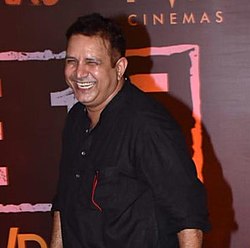

Twin brothers who look alike but live by different values navigate a world of crime, betrayal, and love. Their contrasting choices test their bond, leading them through challenges that reveal the complexities of human nature. In the end, they seek redemption and understanding of each other's paths.
September 19
2025
Release Date
Hindi
Language
56 minutes
2 hours
Running Time
Cast


Vedika Pinto


Durgesh Kumar


Mukesh Bhatt


Kailash Nath


Jameel Khan


Kumud Mishra













Monika Panwar













Aaishvary Thackeray













Mohd. Zeeshan Ayyub













Ghanshyam Garg













Abhishek Sharma













Rishi Kumar













Devendra Charankar













Vinod Kumar Gupta













Jyotish Srivastava













Pankaj Dinkar













Shivam Pandey













Rupak Verma
3.0
Average Rating
The above-mentioned average rating is based on the derived ratings of multiple review platforms
OH Review


Nishaanchi - A Movie Review
Plot
Nishaanchi, directed by Anurag Kashyap, delves into the chaotic world of crime, family dynamics, and deeply rooted rivalries, set against the backdrop of early 2000s Uttar Pradesh. The storyline revolves around the lives of twin brothers, Babloo and Dabloo, played by debutant Aaishvary Thackeray in an impressive double role. While Dabloo is characterized by his timid nature and quiet demeanor, Babloo embodies a brashness inspired by the infamous character, Tony Montana from the classic Scarface movie. This distinctive contrast in their personalities drives the narrative forward.
The film opens dramatically with a failed bank heist involving Babloo and Dabloo along with Rinku, a woman whose character is pivotal to the unfolding drama. Rinku is initially portrayed as someone trying to regain her footing after a series of unfortunate events in her life, including the loss of her father. As Babloo's ambitions lead him into the criminal world, particularly working for a local gangster named Ambika Prasad, the film shows how their paths intertwine amidst suspense and betrayal.
What sets Nishaanchi apart is its balance of various genres within a singular narrative. The film is not just a crime drama; it incorporates elements of romance, familial struggle, and dark humor—much akin to Kashyap's earlier works. However, despite the allure of a gripping storyline filled with familiar Hindi cinema tropes like 'baap ka badla' (father's revenge) and the quintessential romantic angle, the film doesn't quite reach the heights of cinematic brilliance that Kashyap is renowned for.
It’s not just the present that unfolds in Nishaanchi, as the film frequently employs a non-linear narrative, taking audiences back in time to explore the complex familial history that has shaped the characters we see today. While these shifts serve to enrich the storyline, they can also lead to disjointed pacing, especially given the film's imposing three-hour runtime. This lengthy duration tests the viewers' attention span at points, leading to a sense of predictability that detracts from the thrills initially presented.
The film relies on a blend of ambition and nostalgia; however, there is a lingering comparison to Gangs of Wasseypur, which creates a shadow that Nishaanchi struggles to escape. The richness of characters, dramatic confrontations, and emotional weight present evoke reminders of Kashyap’s earlier cult classic. Ultimately, while the film packs a punch with its ambitious storytelling and vibrant character arcs, it occasionally falters under the weight of its length and predictability, leaving viewers wondering about the potential of what could have been.
Acting
Aaishvary Thackeray's debut performance in a double role is a towering achievement that deserves significant acclaim. He manages to carve out two distinct identities in Babloo and Dabloo, delivering performances that resonate with authenticity. Babloo's flamboyant swagger stands out against Dabloo's timid nature, and Thackeray expertly breathes life into both characters, depicting their complex dynamics with a captivating authenticity. His successful portrayal is a testament to his skill, evoking both charm and tension as the narrative unfolds.
Supporting Thackeray is a robust cast, notably Monika Panwar as Manju, their single mother. Despite being somewhat miscast in the role of a mother to adult twins, she manages to showcase a presence that grows in conviction with each passing scene. Particularly memorable is her fierce comeback to a man driven by lust, exemplifying the strength and nuanced femininity of her character. Although the film does weave through some rocky thematic territory, Panwar remains a notable bright spot throughout.
Vedika Pinto plays the role of Rinku, skillfully portraying the complexities of her character who oscillates between victimhood and strength. While there are some criticisms regarding how her character fits into the larger narrative—as her motivations sometimes seem unrealistic—Pinto shines in her moments of vulnerability and tenacity, making her a multi-dimensional element in a predominantly male-centered film.
Meanwhile, Kumud Mishra’s portrayal of Ambika Prasad adds another layer of depth, bringing quiet menace to the film, pushing the narrative along while intensifying the stakes. His character serves as an excellent foil to Babloo’s impulsive nature, and Mishra handles the nuances exceptionally well. The supporting cast, including Mohammed Zeeshan Ayyub as a crooked cop, provides an array of performances that, while some do feel underutilized, still manage to leave an impression, weaving together the film's chaotic yet engaging fabric.
Overall, the performances in Nishaanchi, anchored by Thackeray's dual roles, contribute significantly to the film's overall impact. The chemistry among the actors and their ability to navigate the script's emotional depth showcase Anurag Kashyap’s strengths, reuniting him with actors who can embody complex characters, even in a flawed narrative. Their efforts create an engaging atmosphere that remains entertaining, despite the film's pacing issues and predictability.
Cinematography
Cinematographer Sylvester Fonseca elevates Nishaanchi with his impressive technical work, capturing the various nuances of the narrative through a lens that feels both intimate and expansive. The film's settings in Kanpur are not merely backdrops; they are alive with authenticity and vibrance. Fonseca’s lens provides a detailed exploration of the local landscape, encompassing the gritty realities of life in the heartlands, and illustrating a world filled with tension and tumult.
One noteworthy aspect of the cinematography is the way it captures the claustrophobic intensity of various scenes, particularly during moments of violence and confrontation. Whether it’s tight shots of the characters in a cramped space or wide angles showcasing the chaos of a gang fight in a narrow alley, every frame is thoughtfully considered to evoke a visceral response from the audience. The cinematography does an excellent job of balancing the somber tones of the narrative with the dynamic action sequences—showcasing shootouts, fierce brawls, and passionate moments of dance and revelry.
Fonseca also cleverly employs lighting and color palettes that reflect the mood shifts throughout the film; from the smoky interiors of drinking holes to the vibrant streets bustling with energy, the camera encapsulates the feel and essence of the setting. Furthermore, with the integration of rhythmic edits and strategic use of close-ups during pivotal moments, the film maintains a compelling visual pace that keeps viewers engaged, despite its lengthy runtime.
An additional layer that enriches the viewing experience is the incorporation of music, which is curated to enhance the film’s emotional landscape. While the songs may lack the distinct zing seen in Kashyap’s earlier works, the incorporation of folk-inspired tracks continues to resonate with the film's thematic intentions. The music blends seamlessly within the narrative structure, helping to guide the viewer through the emotional highs and lows while connecting deeper with the characters.
Overall, the cinematography in Nishaanchi is one of its strong suits. It creates a foundation that bridges the narrative’s various elements, culminating in a seamless yet deliberate portrayal of a world rife with complexity and conflict. Through Fonseca’s lens, the film captures the heartbeat of its characters and their surroundings, providing an authentic visual experience that resonates long after the credits roll.
Direction
Anurag Kashyap’s direction in Nishaanchi presents a colorful departure from his earlier, more brooding styles, allowing viewers to experience the director in a more playful, yet still intricate storytelling mode. Returning to a theme that resonates deeply with his previous work, Kashyap offers a film that gleams with vibrancy and chaotic energy while remaining grounded in the familial and criminal intricacies reminiscent of Gangs of Wasseypur. His ability to infuse humor, quirk, and local culture into the narrative speaks to Kashyap’s strengths as a creator, adept at capturing the heart and soul of his characters and their struggles.
The film successfully fuses elements of action, drama, and romance, which hark back to quintessential masala films. However, the intentional mix sometimes causes the narrative to waver; with an ambitious runtime of nearly three hours, the pacing occasionally falters, leaving audiences in waiting for the action to pick up. There are stretches where the film meanders, testing viewers' patience as it labors through character backstories that don’t always seamlessly align with the main arc.
Kashyap’s strength lies in his dialogue writing, with incisive, witty exchanges that offer glimpses of dark humor amid heavy themes, though occasionally, the timing of deliveries falls flat. Moments that should resonate as impactful fail to ignite the tension as they should, leading to a dissipating energy. Nonetheless, his passion for character-driven narratives shines through, and even when the script wades through predictable or lengthy moments, the raw emotions conveyed firmly ground the film.
Notably, Nishaanchi is divided into seemingly digestible segments, making it easier for audiences to navigate its complex narrative. Despite its predictability, Kashyap’s willingness to delve into multifaceted storylines and explore the ramifications of decisions made by the family ensures that viewers remain engaged. The film's ambition to weave a rich tapestry of interconnected tales within its framework is commendable, particularly in light of how various characters contribute to the overarching themes of love, loss, and revenge.
As the film approaches its somewhat unsatisfying climax, Kashyap does leave audiences with a tantalizing sense of curiosity for what lies ahead in the sequel, suggesting that the groundwork laid in this film could lead to something more compelling. If only Kashyap could find the right balance between indulgence and conciseness, his artistic vision has the potential to elevate the sequel beyond the premises established in this initial installment.
Conclusion
In conclusion, Nishaanchi emerges as an entertaining, albeit flawed, entry in Anurag Kashyap’s oeuvre—a film that dances around the intersection of crime, familial ties, and personal ambition. While it does not reach the monumental heights of its predecessor, Gangs of Wasseypur, it offers enough charm and engaging storytelling to keep audiences intrigued. The film’s exploration of the conflict between the brash and the reserved within a familial context continues to resonate, even when some narrative arcs might feel predictable.
Thackeray’s commendable performance sets the stage, supported by a talented cast, each contributing to a multilayered portrayal of a world riddled with crime, love, and revenge. Kashyap’s direction ensures that audiences feel a sense of familiarity while simultaneously introducing new facets of storytelling that refresh the genre.
Although the film does suffer from pacing issues and should perhaps shed some of its pretentious indulgences, it still functions effectively as a solid piece of entertainment. The cinematography captures the chaotic beauty of Kanpur, underscoring the movie’s authenticity. As Kashyap reclaims some of his comedic flair and stylistic quirkiness, he stands poised to develop a rich sequel that might surpass the maiden tale.
All in all, if you’re looking for a film that combines action, humor, and familial strife while delivering a glimpse of Kashyap’s artistic nuance, Nishaanchi is worth a watch. Whether it lives up to the legacy of its predecessors is debatable, but it certainly lays a colorful and ambitious foundation for further exploration. Here’s hoping for a sequel that captures the essence of its characters with tighter storytelling and even greater depths to explore.
Share this review
The Great Reviews
Times of India
Rediff
NDTV
India TV
More like this
Dhurandhar
In Dhurandhar, in "Dhurandhar," a gripping tale unfolds as a group of Indian heroes confronts the underworld's darkest forces. Inspired by real events, the f...
Zootopia 2
In Zootopia 2, brave rabbit cop Judy Hopps and clever fox Nick Wilde reunite to solve their toughest case yet. As they navigate twists and turns in a mysteri...


